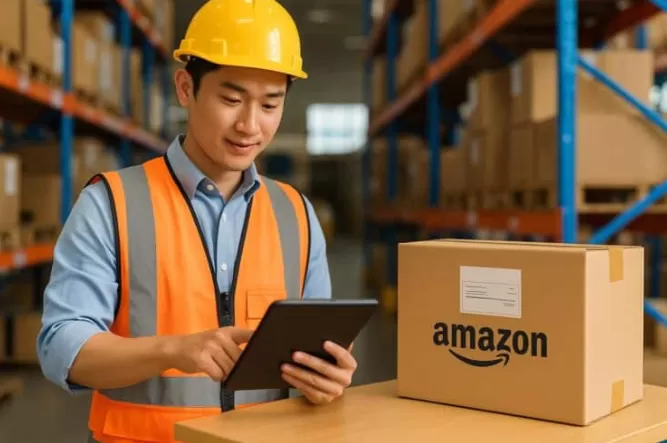Your supply chain is only as strong as its weakest link. For Amazon sellers, that link is often the freight forwarder. Choose wrong, and you’ll bleed money on hidden fees, storage, and missed deliveries that hammer your IPI score. This guide cuts the fluff. We’re giving you an operational checklist to qualify partners based on the three pillars that actually matter: FBA mastery, operational transparency, and cost clarity.
Why Your Forwarder Choice Makes or Breaks Your Business
A forwarder isn't a vendor; they're your logistics arm. A-tier partners navigate customs snags and deliver to Amazon on time, every time. B-tier partners create crises:
IPI Score Collapse: Late shipments inflate storage costs and crater your Inventory Performance Index.
Stockouts: Shipping delays empty your inventory and erase product rank.
Margin Erosion: Unexpected duties, storage demurrage, and rework fees vaporize your profitability.
The Forwarder's Core Workflow: Know What You're Buying
Amazon FBA
Get real-time quotes for today
Get Quotes
You can't manage what you don't understand. Here’s the end-to-end process a competent forwarder owns:
Origin Handling: Collection and warehousing at the origin port (e.g., Shenzhen, China).
Export Customs Clearance: Processing the export declaration (EEI) locally.
Main Leg Transport: Securing space on ocean or air carriers.
Import Customs Clearance: The make-or-break phase. Their broker files ISF, PGA, and CBP paperwork and pays duties on your behalf.
Final Mile to FBA: Drayage to the designated Amazon FC (e.g., ONT8).
FBA Compliance Execution: Ensuring cartons and pallets are built to Amazon's exact FBA requirements to avoid receiving delays.
The Bottom Line: Their value isn't in moving boxes; it's in executing steps 2, 4, and 6 flawlessly. That’s where expertise pays for itself.
The Evaluation Framework: 3 Pillars of a Top-Tier Forwarder
Forget price shopping. Use this framework to qualify partners.
Pillar 1: FBA-Specific Operational Mastery
This is non-negotiable. Your partner must speak Amazon's language.
FBA Compliance in Their DNA: They should proactively enforce Amazon's FBA packaging, labeling (FNSKU), and palletization standards—before your cargo sails.
Amazon Partnered Carrier Status: Are they on Amazon's list? This grants access to discounted rates and streamlined shipping workflows within Seller Central.
Bonded Carrier Authority: Simplifies customs bonding and can provide flexibility for deconsolidation.
Pillar 2: Operational Transparency & Communication
Surprises are failures. Demand visibility.
Single Point of Contact: You need a dedicated ops lead, not a generic support queue.
Real-Time Tracking Portal: A system that provides status updates from the factory floor to the FC dock—not just carrier tracking numbers.
Proactive Alerting: They flag potential delays (e.g., customs exam, vessel diversion) with a contingency plan before you have to ask.
Pillar 3: Total Cost Clarity
The cheapest rate is the most expensive mistake. Audit for value.
All-Inclusive DDP Quotes: Require Delivered Duty Paid quotes. The all-in number must include freight, fuel (BAF), customs clearance, duties, taxes, and trucking. Reject DAP quotes that leave you holding the bag for unpredictable import costs.
Zero Hidden Fees: Drill down on line items. Ask: "What are your fees for storage, re-weighs, CFS handling, or BOL amendments?"
Forwarder Service Tier Comparison
| Feature |
Cost-First Option |
Balanced Value |
Service-First Partner |
| Communication |
Reactive email-only |
Portal and email support |
Dedicated agent, proactive alerts |
| Quoting |
DAP common, fees hidden |
DDP available |
All-in DDP standard, full breakdown |
| FBA Expertise |
Generalist |
Basic knowledge |
Expert-level, Amazon-integrated |
| Best For |
Non-urgent, low-risk cargo |
Standard shipments |
High-value, time-sensitive goods |
How to Source and Compare Quotes (Apples-to-Apples)
Control the variables. Send every forwarder the same RFQ packet:
Product HS Code: The harmonized code dictates duty rates.
Origin/Destination: Exact addresses (e.g., factory in Ningbo to IND9).
Cargo Details: Gross/net weight, carton dimensions, total volume (CBM).
Incoterm: Mandate: "Quote required under DDP terms."
Use our scorecard (below) to run a structured evaluation.
The Execution Tools: Your Vetting Playbook
Download: The FBA Forwarder Vetting Scorecard
Stop guessing. Score partners objectively on a 100-point scale.
This isn't a blog post—it's an ops tool. It includes:
Scored questionnaire for discovery calls.
Line-item cost audit checklist.
Reference check scripting.
Red Flags: Immediate Disqualifiers
Opaque Quoting: Hesitance to provide a firm, all-in DDP quote.
Slow Response Time: If they're slow during the sales process, they'll be catastrophic post-booking.
No FBA References: Cannot provide specific examples of solving Amazon-specific compliance or delivery issues.
Pressure to Sign: Legitimate partners educate and prove value; they don't hard close.
FAQ: Straight Answers to Operational Questions
Q: How does Amazon Global Logistics (AGL) stack up?
A: AGL is a valid option for simplicity and Seller Central integration. However, it often lacks the flexibility and personalized service of a high-end specialist forwarder. Always get a quote from AGL and two external partners. The competition keeps pricing sharp.
Q: Freight forwarder vs. customs broker—what's the difference?
A: A freight forwarder orchestrates the entire move. A customs broker is a licensed specialist who files entries with CBP. A full-service forwarder will employ or subcontract a broker so you have one point of contact.
Q: What's a realistic lead time for booking?
A: Ocean: Book 4-5 weeks before your CRD (Cargo Ready Date). Air: 7-10 days. Build in a buffer for production delays and port congestion, especially around peak seasons.
Q: What's the single best question to ask a potential forwarder?
A: "Walk me through your contingency plan for a customs hold at LAX port. What are your immediate steps, and how do you communicate them to me?" Their answer reveals their operational depth and communication protocol.

 EN
EN
 FR
FR
 ES
ES
 JA
JA
 PT
PT
 RU
RU
 AR
AR






